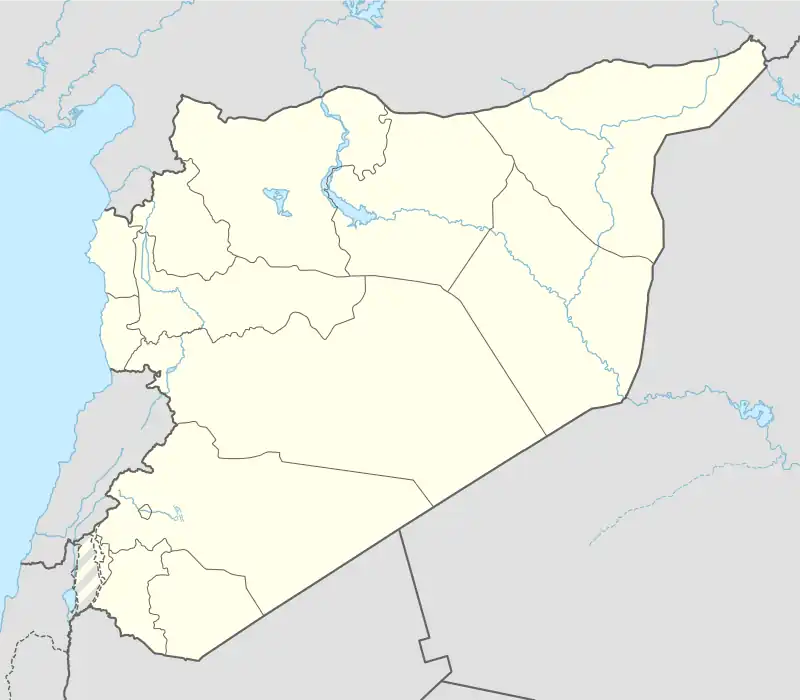Sahwat al-Khudr
Sahwat al-Khudr (Arabic: سهوة الخضر; also spelled Sahwat al-Khidr or Sahwet el-Khodar) is a village in southern Syria, administratively part of the al-Suwayda District of the al-Suwayda Governorate, located south of al-Suwayda. In the 2004 census, it had a population of 3,625.[1] The village is named after a Byzantine-era church named dedicated to Saint George (known by local Muslims as "al-Khudr"). It was resettled by Druze in the mid-19th century after a period of abandonment.
Sahwat al-Khudr
سهوة الخضر | |
|---|---|
Village | |
 Sahwat al-Khudr | |
| Coordinates: 32°36′8″N 36°42′27″E | |
| Grid position | 310/224 |
| Country | |
| Governorate | as-Suwayda |
| District | as-Suwayda |
| Subdistrict | as-Suwayda |
| Population (2004 census) | |
| • Total | 3,625 |
| Time zone | UTC+2 (EET) |
| • Summer (DST) | UTC+3 (EEST) |
History
This village is probably the center of Biblical "Kedar," a regional nation of nomadic shepherd-people who inhabited the general area.[2] The 19th century German visionary Bl. Anne Catherine Emmerich mentions "Cedar" as also being a city, presumably this city (as verified by her detailed descriptions), to which Jesus visited, so she says, on an historically unrecorded journey.[3]
Sahwat al-Khudr receives its name from an ancient Byzantine church dedicated to Saint George, who is identified with "al-Khudr" by Muslims. An inscription on a monument in the church dates back to 306 CE.[4]
Ottoman era
In 1596 it appeared in the Ottoman tax registers under the name of Sahut al-Qamh, located in the Nahiya of Bani Nasiyya of the Qada of Hawran. The population was 142 households and 54 bachelors, all Muslim. They paid a fixed tax-rate of 40 % on agricultural products, including wheat, barley, summer crops, vineyards, goats and beehives; in addition to occasional revenues and a water mill; a total of 31,300 akçe.[5]
In 1838 Eli Smith noted that the place was located South of Juneineh and that it was in ruins.[6] Sahwat al-Khudr had been abandoned for a time, but was settled by Druze between 1857 and 1860 at the encouragement of Ismail al-Atrash, a prominent Druze sheikh (chieftain) in the Hauran.[7] In the mid-19th-century, Albert Socin, a European orientalist noted that Sahwat al-Khudr was "a dilapidated town with a castle and a church" surrounded by a forested area. The shrine of al-Khudr in the village was revered by all the religious sects of the vicinity.[8]
Modern era
In the late 1960s, French geographer Robert Boulanger described Sahwat al-Khudr as "a very picturesque place" with an old mosque that was formerly a pagan temple in Antiquity.[9] The mosque's prayer room contained a column with Nabataean inscriptions.[9] The people of the village slaughtered sheep outside of the mosque annually.[9]
Geography
Nearby localities include Salah to the northeast, Miyamas to the north, Hubran to the northwest, Salkhad to the southwest and Orman to the south.
References
- "General Census of Population 2004". Retrieved 2014-07-10.
- "Kedar". Jewish Virtual Library. Retrieved 3 January 2021.
- Emmerich, Bl. Anne Catherine (1914). The Life of Our Lord and Savior Jesus Christ. Vol. 3, §4, Chapter 4, "Jesus in Cedar". Retrieved 3 January 2021.
{{cite book}}: CS1 maint: location (link) CS1 maint: location missing publisher (link) - Porter, 1868, pp. 488-9
- Hütteroth and Abdulfattah, 1977, p. 210
- Robinson and Smith, 1841, vol 3, 2nd appendix, p. 160
- Firro, 1992, p. 189
- Socin, 1876, p. 412
- Boulanger, 1966, p. 515
Bibliography
- Boulanger, Robert (1966). The Middle East, Lebanon, Syria, Jordan, Iraq, Iran.
- Firro, Kais (1992). A History of the Druzes. Vol. 1. BRILL. ISBN 9004094377.
- Hütteroth, Wolf-Dieter; Abdulfattah, Kamal (1977). Historical Geography of Palestine, Transjordan and Southern Syria in the Late 16th Century. Erlanger Geographische Arbeiten, Sonderband 5. Erlangen, Germany: Vorstand der Fränkischen Geographischen Gesellschaft. ISBN 3-920405-41-2.
- Porter, J.L. (1868). A Handbook for Travellers in Syria and Palestine. Vol. 2. Murray.
- Robinson, E.; Smith, E. (1841). Biblical Researches in Palestine, Mount Sinai and Arabia Petraea: A Journal of Travels in the year 1838. Vol. 3. Boston: Crocker & Brewster.
- Socin, A. (1876). Baedeker, K. (ed.). Palestine and Syria: Handbook for Travellers. Karl Baedeker. p. 412.
External links
- Map of the town, Google Maps